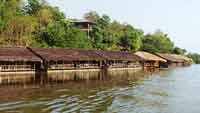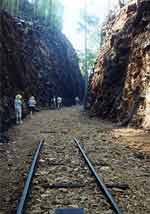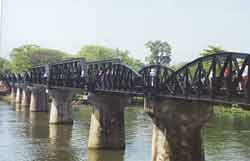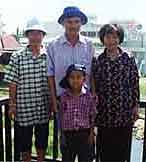
Travel
|
By Gyn Gerhardt I first viewed the River
Kwai as I descended the steps from the jungle lodge to my floating
thatched roof cottage. This was not the picture of this river during World War II. From 1941 through 1945, Kamchanburi was home to many prisoners of war and 20,000 families lost their sons here to the perils of the jungle and the hands of the enemy. While those American soldiers have all returned to the USA, a memorial cemetery here is the final resting place for many of our men from Australia, France, England, and Holland, as well as Thailand. The Australians host the memorial Jeath Museum to remind us what these prisoners of war endured when they built the important railroad through the jungle to Burma.
In the movie "The Bridge Over The River Kwai," in the end the U.S. bombs the bridge and the war is over. Today the bridge has been rebuilt and the train does run on it for local use. We were able to walk over the bridge and many locals and tourists do. Our guide warned us to hurry, as the train was due shortly. However, there were bays built into the sides of the bridge for us to scramble to when the train came.
Later, we rode the ancient train, swaying to and fro along the river's edge and through the beautiful peaceful countryside. It seemed difficult to envision the terror that once griped this area in the 40's. Now, nature has healed its wounds, but never the sorrow of the families once torn apart by the ravages of war. After a delicious dinner at the lodge, I climbed into my bed that lay upon the raft floor. Sounds of the river and the jungle under a full moon wooed me to sleep. I felt overwhelmed with the adventures of the day past, but sleep called too soon. Thailand is most interesting in that while we traveled from the south of the country to the north, over mountains and through the jungle, I never saw one pine tree (I'm allergic). This is the first country I have discovered which doesn't grow some form of pine. What the jungle does contain is bamboo, teak, coconut palms, bananas, and numerous flowering trees. They have but three seasons - winter, summer, and monsoon. Winter is the best time to visit, as there is always something in bloom. Summer is hot with unbearable humidity. Monsoon, well we all know what that means and why the homes are raised; the country floods. Part One: Bangkok |
|
Topics:
Living | Health
| Money | Travel
| Services | Shopping Resources: Online Forums | Privacy Policy | Feedback Copyright © 2000-2002 Our Privacy Policy |


 The
river is quite placid and about the width of a city block, lined
with bamboo, coconut palms and flowering trees. Jasmine filled the
air and exotic birds sang endlessly. In the distance I could see
a farmer with his water buffalo tilling a field. After settling
in, I joined the rest of the group next door on another floating
raft. As we were pulled down the river by a long tailed boat to
view the exotic birds, we supped on tempura made from fresh exotic
flowers and cold Thailand brewed beer.
The
river is quite placid and about the width of a city block, lined
with bamboo, coconut palms and flowering trees. Jasmine filled the
air and exotic birds sang endlessly. In the distance I could see
a farmer with his water buffalo tilling a field. After settling
in, I joined the rest of the group next door on another floating
raft. As we were pulled down the river by a long tailed boat to
view the exotic birds, we supped on tempura made from fresh exotic
flowers and cold Thailand brewed beer.  We
hiked into Hell Fire Pass, barely able to make it ourselves. A few
of our group couldn't and turned back even though we had concrete
steps to climb and were wearing boots. The soldiers had neither
and were clothed only in loincloths. Malaria, dysentery and lack
of food couldn't keep them from their forced labor, only a final
death did.
We
hiked into Hell Fire Pass, barely able to make it ourselves. A few
of our group couldn't and turned back even though we had concrete
steps to climb and were wearing boots. The soldiers had neither
and were clothed only in loincloths. Malaria, dysentery and lack
of food couldn't keep them from their forced labor, only a final
death did. I
walked the bridge, reliving the scene from the movie where the bamboo
structure to support the bridge was "accidentally" destroyed
by our soldiers. My mind traveled back to the emotions of that time.
Suddenly, my arm was being pulled towards a bay. There stood a Thai
family of four beckoning me to join them. Hmmmm, I thought, the
train must be coming. No, they wanted pictures for the family photo
album. Each one, in turn, took photos, including me. I don't know
why, but it seems this happens a lot in Thailand. Thai people are
friendly to tourists and especially Americans.
I
walked the bridge, reliving the scene from the movie where the bamboo
structure to support the bridge was "accidentally" destroyed
by our soldiers. My mind traveled back to the emotions of that time.
Suddenly, my arm was being pulled towards a bay. There stood a Thai
family of four beckoning me to join them. Hmmmm, I thought, the
train must be coming. No, they wanted pictures for the family photo
album. Each one, in turn, took photos, including me. I don't know
why, but it seems this happens a lot in Thailand. Thai people are
friendly to tourists and especially Americans. "Sawadee
kaa", I said with hands folded in prayer to my face. "Sawadee
kob" the family said as they bowed, returning the gesture.
This is the universal Thai greeting of respect. It means hello,
good-bye, have a nice day, or just thank you. It gently expresses
and warmth and respectful nature of the Thai people.
"Sawadee
kaa", I said with hands folded in prayer to my face. "Sawadee
kob" the family said as they bowed, returning the gesture.
This is the universal Thai greeting of respect. It means hello,
good-bye, have a nice day, or just thank you. It gently expresses
and warmth and respectful nature of the Thai people.